The Truth About Trichotillomania
A documentary with pictures included of how a debilitating disorder can affect one's life.

Hair. Some say that a woman’s hair is her crown, beautifully crafted to frame the face in such a way that speaks to those around her. Each strand combines with the others to create an exquisitely coiffed masterpiece. Hair is extremely versatile: it can be cut, dyed, curled, straightened, highlighted, and brushed into any number of gorgeous styles that expresses a bit of one’s inner workings. All of this has been stripped from my identity because I have a disorder called trichotillomania. Sometimes a “bad hair day” can affect your emotional state of mind. I, unfortunately, suffer from a permanent bad hair day.
Trichotillomania is a mental health disorder that causes a person to have a compulsive and overwhelming desire to pull hair out of their head, eyebrows, arms, legs, or pubic area. It commonly surfaces in late childhood to early teenage years and is often provoked by a traumatic event. Studies have shown that 0.6%-3.6% of adults suffer from Trichotillomania. Specialized treatment for this particular disorder is scarce and there are no known psychiatric medications that can cure this ailment.
Trichotillomania resides under two mental health umbrellas: anxiety disorders and obsessive compulsive disorder. Anxiety is one of the main emotions that people have reported they feel when they have the urge to pull their hair out. The obsession and compulsion are inherent in this disorder and can overwhelm an individual’s mind until there is relief felt by pulling hair out from one’s preferred spot. To get a clearer picture of what it’s like to live with this debilitating disorder, I’d like to share my own experience with trichotillomania and where I’m at today.
It all started back when I was twelve years old. My parents sat my sister and I down and gave us life-shattering news: their 16 year marriage had devolved into irreparable differences (aka my father was having an affair with a much younger woman who worked at his place of employment). Everything I knew to be true in life up to that point had been turned upside down by the fact that my parents couldn’t make their marriage work and for that reason, I had to leave my beloved childhood home behind and move to a smaller house in a tiny town in Pennsylvania called Robesonia.
This town, about 5–10 minutes from where we were living, is so small that if you blink as you’re driving through, you might actually miss it. My mom, my sister, and I left our home with the hopeful reassurance from my parents that they really were trying to work out their issues and perhaps reconcile in the future.

Those prospects were decimated when it was revealed that my dad was having an affair with a woman he worked with who was much younger than him. She was well known to the entire family as my father used to entertain his work colleagues quite frequently in the summer at our backyard BBQ’s and pool parties. Never did I think that she was anything other than an awesome friend of my dad’s. She was actually a cool older sister type and pretty popular with my family as she’d dress up in our Brownie uniforms and sell Girl Scout cookies for us or casually bring over a casserole so my Mom wouldn’t have to cook.
I’d had my suspicions of my father having an affair during the first few visitations my sister and I had with him after we moved out. I noticed women’s perfume and shampoo that didn’t belong to my mother in his shower. His bedroom door, which was previously ripped off its hinges during a terrible scuffle between my parents, had promptly been reattached. So when the news finally surfaced in the form of our old next door neighbor calling my mom and telling her that she had seen my soon to be step-mother’s car at my revered childhood home overnight, I felt betrayed.
My next thought was about my mother. My poor mother did not deserve any of this. She was a dutiful and supportive wife and a loving and caring mother. She always wanted to be a mom. She wanted to be a mom so much, in fact, that my dad told me that the only reason they had children was because, at 26 and after a few years of marriage, she insisted that she wanted to get pregnant or she would leave my dad and he conceded. She was born to be a mother and is the epitome of what a mother should be, unlike my father who continued to carry on with his selfish ways, including staying out late, working long hours, and having affairs.
To this day, I don’t know how my mom survived the affair and subsequent divorce. To say it was contentious is an understatement. Soon, my dad and his new girlfriend and her almost one year old son moved in together and moved out of my childhood home. They bought a house in Womelsdorf with a long gravel driveway that ended in the middle of the woods. My sister and I had to visit with them every weekend. It was there that my journey with trichotillomania began.
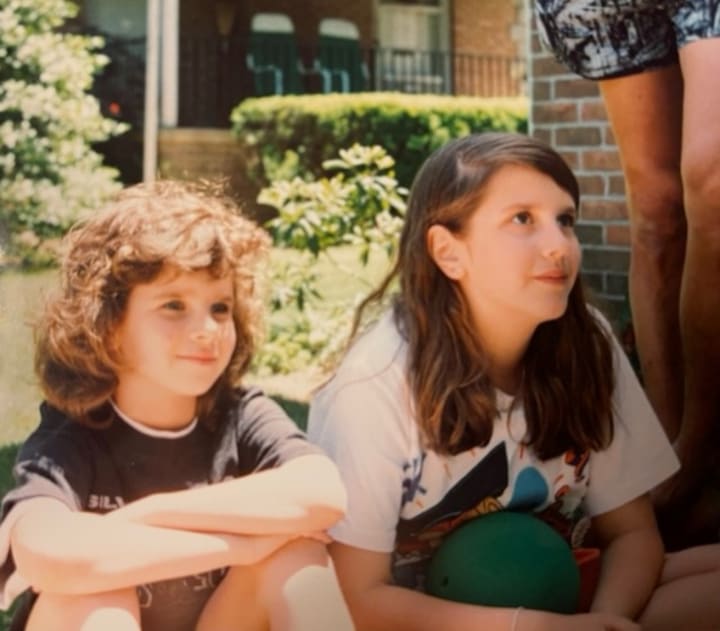
I felt completely uncomfortable with the new step-family I had inherited. I was so angry with my father and his girlfriend for upending our lives and destroying my mother. She always made sure we were taken care of, but she was deeply depressed and it was obvious that the divorce had taken a toll on her when she’d come home from her nursing job at 3:30pm and go right to bed. Her pain was my pain. I couldn’t stand to see a once vibrant and confident woman beaten down by the man she loved.
All of this anger, depression, anxiety, betrayal, and pain was reaching a boiling point. I had already started acting out at school. Once the perfect, straight A student, I didn’t care about much anymore. I was having trouble with friends, experimenting with drugs, skipping classes, and sneaking out late at night. I was trying to find myself at a time when my foundation was so shaky and I felt like I had no one to catch me as I fell through the cracks.
I can still remember the first night I pulled my hair out. I was at my dad’s house, watching TV with my newly inherited family. There was nothing that happened that night that I can point to now and say, “this is exactly why I started pulling my hair out.” To be completely honest, I’m just as perplexed as psychologists are about why I did it. I had beautiful, thick, long brown hair and I had never pulled it before or even thought about doing such a thing. But for whatever reason that night, my hand made its way to the crown of my head and started pulling. It wasn’t like I freaked out and started ripping clumps of hair out of my head. Although I felt anger, hurt, and anxiety in the inside, the act of pulling was quiet, subdued, and calming. I felt instant relief.
Pulling my hair out felt surprisingly good. It was a satisfying and soothing feeling, almost like watching a visually-stimulating ASMR video with raking sand or cutting floral foam. Pulling hair was like an art form to me. I was looking for a certain type of hair. Hair strands that felt particularly good to pull usually had a kinky texture. At first, my hair was devoid of kinky strands. But the longer I pulled and the more I damaged the hair follicles, the more my hair grew back kinky and frizzy and sometimes completely white. Those were the strands that I targeted. Also, I liked to pull the hair strands that came out without a lot of force. I knew that if it was too difficult to pull, I wouldn’t receive the desired effect.
The goal of hair pulling is to get strands with the root bulb still attached. Pulling hair without the root bulb attached was not satisfying to me. I didn’t like the way it felt when I was plucking them out of my head. I had an agenda while I was engaging in this behavior. After the hair was pulled, it brought me great pleasure to play with the root bulb. I liked to pull the hair with the root bulb attached across my lips.
It’s hard to describe what I got out of this practice. The root bulb felt cold and moist and just the slightest bit sticky. Sometimes I would pull the strand of hair through my fingers, waiting in anticipation for the part when the root bulb would pass through my pursed fingers. Once the hair began to lose the cold and moist feeling (that’s the best way I can describe it), I would be done playing with it and I would usually use my fingernails to rip the root bulb off of the hair. Then I would discard the hair, sometimes in a trash can, but often I’d just drop them on the floor around where I was sitting. Some people who have trichotillomania will bite, chew, or ingest the hair. People will also sometimes find a substitute for hair-pulling by pulling strands out of garments or dolls.
For a long time, I was not only pulling the hair out of my head, but I also pulled the hair out of my wigs. Sometimes hair pulling is purposeful and focused; other times it can happen subconsciously while an individual is engaged in other activities, such as watching TV or reading a book. There were often times that I would catch myself in the middle of pulling my hair, not realizing that I had pulled so much that I created a new bald spot.
I preferred to pull from the top of my head or around the front of my hairline. Hair that was attached lower on my scalp towards the back of my neck didn’t possess the same sensation that I got with hair from the top of my head. The pulling got really bad in my 9th grade year. You could really tell if you put my 8th and 9th grade pictures side by side. In 8th grade I had long, thick, straight hair that fell a few inches below my shoulders. In 9th grade I had thin orange-hued hair after I tried to dye it blonde. The difference is remarkable.
Now that the bald patches and thinning hair was becoming increasingly noticeable, I was beginning to have a difficult time at school and in other social situations. My biggest fear was someone hovering over me while I was sitting or kneeling, giving them the perfect view of the top of my head. I can remember sitting at my desk at school and cringing with every ounce of my being as if to prevent from being seen as classmates walked by me. One day, I was sitting on the grass outside my house with friends when one of the girls stood up and proceeded to come extremely close to my head, as if she was conducting an inspection. “Monica, you’re going bald.” She said in a mocking tone. I was mortified. I still didn’t know what this thing was or why I was doing it. I felt like a freak of nature. All I could think to say was “no I’m not,” and I quickly changed the subject.
My mom had sent me to a therapist after she and my dad divorced. The therapist was the next one to question my hair loss. She initially asked me if the antidepressant she had prescribed me was making my hair fall out. When I told her no, she asked me if I was pulling my hair out. Of course, I denied it quicker than she could even ask the question. She poked and prodded me for the entire hour, but there was no way I was admitting that I pulled my hair out. I cannot emphasize enough that I felt like an aberration on public display at which all could gawk and gasp. There was no easy answer.
I knew that this problem was not just going to go away. Most unfortunately was that the longer this carried on, the more obvious it would become until we got to the point where I could no longer deny or ignore the existence of this disorder. My mother went on to tell me later that the therapist did tell her that I had trichotillomania. She told my mom to check the floor around the sofas and chairs in the living room or next to my bed and sure enough, she found clumps of hair.
The remainder of my teenage years were very difficult. I started dating my first boyfriend, Nick, when I was 16. At that point, I was always wearing my hair up in a ponytail because it made it easier to hide the bald spots. I don’t remember having a conversation with Nick about my hair, but I must have discussed it with him at some point. At first I think I was able to hide it from him by wearing my hair up. But I continued to pull and soon a ponytail was no longer working to disguise the real state of my hair.
I became pregnant with my first child at 17. The anxiety of preparing to be a teen mom was overwhelming and only exacerbated my hair pulling. At this point I had a really good job working as a Counselor’s Assistant at the Caron Foundation, a renowned drug and alcohol treatment facility that I had actually been a patient at when I was 15. As a recovering addict, I was hired to work at the adolescent center with kids at or around my age. Shortly after securing this great job, I had started wearing a bandana at home and I came to the realization that I would have to wear it at work too. It was completely humiliating, going in to work at a highly respected treatment facility, wearing a bandana with nice work clothes everyday and sometimes in front of the patients’ parents. I was starting to get weird looks from my co-workers and questions from curious patients about why I wore my bandana every day when I came to the realization that something else would have to be done.
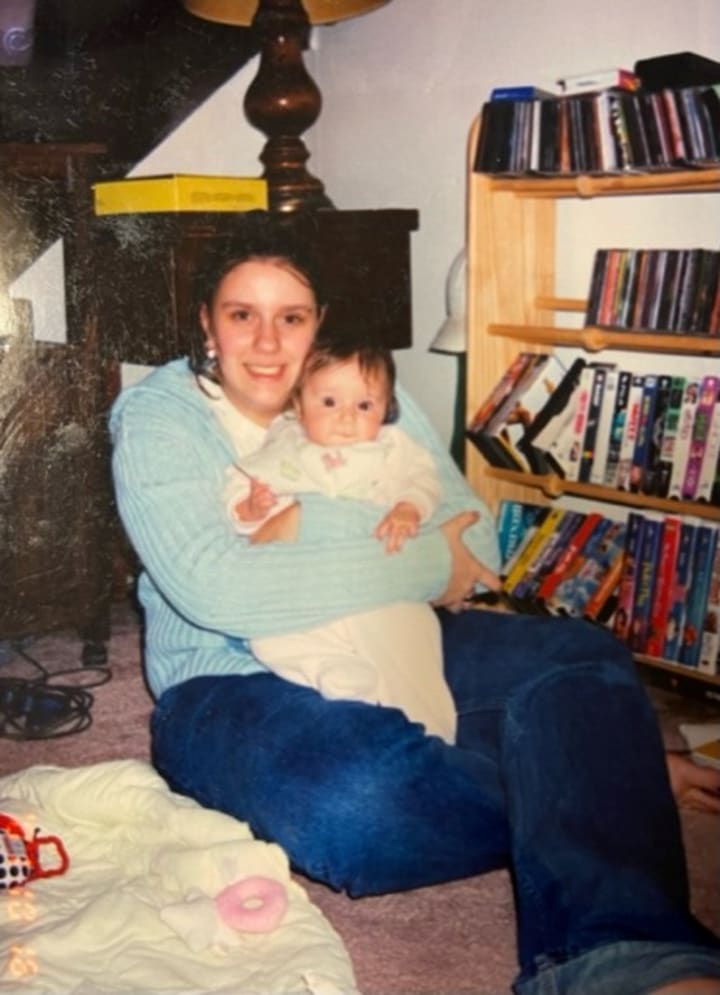
My stepmother’s mom, Barb, has alopecia and has been completely bald for decades. She knew a bit about my problem because, when my dad and stepmom got married when I was 15, I couldn’t get my hair done with everyone else in the wedding party because of my bald patches. Instead, my stepmom’s aunt ended up doing my hair privately that day.
I ended up reaching out to Barb when I decided that I had to get a wig. I don’t know why I waited so long to go down that road. I think what held me back was the embarrassment of needing a wig and not knowing where to go to find something stylish. Barb was very helpful. She showed me the catalog from the place where she got her own wigs. She reassured me that it was okay to wear a wig and that no one was judging me. I appreciated all of her help and kindness, but unfortunately her wig catalog was for older ladies. I was looking for something that looked young and stylish, especially since it had been ages since I was able to do my hair. I ended up settling for the only wig in the catalog that looked like it might be for someone under the age of 40.
I wasn’t thrilled with my new wig, nor was I completely comfortable wearing it. It was a cheap human hair wig that cost about $100. I was able to cut, curl, and style it, but I usually just wore it as it was because I hadn’t been motivated to research what I could actually do with the wig. It came down to the fact that I felt like it looked extremely fake and I was still so insecure about wearing a wig. In my own mind, wearing a wig was acknowledging that there was a problem. I could make excuses for the bandana, although it wasn’t attractive and made me look unprofessional at work. It was hot, it was itchy, and I spent a long time feeling sorry for myself about having to wear it everyday.

I was about 20 when I split with my daughter’s father. He was emotionally abusive and we both admitted that we were only staying together for our daughter who was about two at the time. About six months later, I met another guy named Mike. I instantly fell in love with him. He was the one and I was certain of that. He was about three and a half years younger than me, but he was extremely mature and intellectual.
Unfortunately, we both had demons…demons that played so well together. Our relationship was a recipe for playing with fire. I was very nervous to tell him about my hair. Luckily, he was totally cool about it. Apparently his mother (who didn’t like me) told him that she noticed I was wearing a wig. He asked me if this was true. I reluctantly told him it was and began explaining to him what I knew about the disorder I had. This was the very first time in my life that I openly admitted to having trichotillomania. Thankfully, his response was loving and compassionate. He didn’t judge me based on my looks. He loved the person that was inside.
When Mike and I started dating, one of the first things we did was relapse on drugs. I had been clean for over four years. My drug of choice was heroin, while his was cocaine. Mike had never tried heroin, and I agreed for the time being that I would keep away from heroin. But soon I began to experience the havoc wrought on my mind by crack cocaine.
When I was high, I would sit and do crossword puzzles and pull my hair out for hours. Now that I was wearing a wig, it caused me difficulty when trying to discreetly pull when people were around. I usually didn’t pull when people were looking at me, but I would pull, for example, in a small social setting, while watching TV. That way, the focus was on the TV show and not me. But since the wig was in my way, I started pulling hair right out of the wig. I was still wearing the first wig I had ever purchased, but it quickly needed to be replaced as the drug use had exacerbated my pulling. Cocaine was a terrible drug choice for me as it only aggravated my most serious mental health issues, including anxiety, obsessive compulsive disorder (OCD), and trichotillomania.
Mike and I moved into our own apartment and I lost my job soon after. We decided to resort to selling drugs, mainly marijuana, to support our drug-fueled lifestyle. I also needed a new wig and with all my cash going into drugs and our new business endeavor, I had to ask my mom for help buying me another wig. This one was another $100 human hair wig. I had my daughter’s stepmom, Carrie, help me as she was a hair stylist and could find better prices for decent wigs. I still had no clue what I was doing. Carrie dyed, cut, and styled the wig and it looked much more youthful than the old one. Unfortunately, it wasn’t long until I had to wear a bandana with the new wig to hide the bald patches I had created in the wig itself.
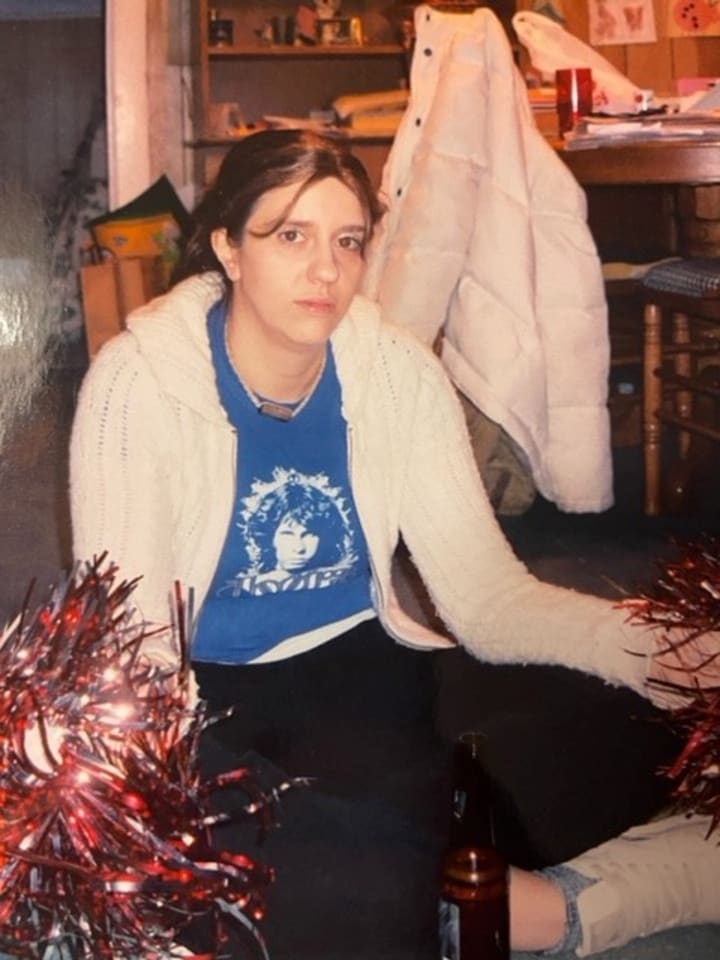
The crack cocaine left me feeling frozen in a state of pure anxiety. I felt like if I moved, my heart might explode. I continued quietly using, pulling my hair out as discreetly as possible, and playing cards, Scrabble, or crosswords in a dark corner of our apartment. People were always coming and going to purchase drugs. Mike’s business plan made me crazy. He had people trafficking in and out at all hours of the night and day. It was his job to sell and my job to go into the city of Reading and pick up pounds of marijuana. All of the drug dealers thought that I didn’t look shady, so they preferred me to Mike.
It wasn’t long before my obsessive compulsive disorder became more of a problem. It intersected with the trichotillomania by my mind telling me I had to pull a certain number of hairs (usually three or sets of three) in a specific amount of time or else something bad was going to occur, like getting arrested or Mike leaving me or even death. I was tortured day in and day out with these intrusive thoughts and forced compulsions that I could not stop.
Soon all the chaos would come to a head. It was February 4, 2004 and I was just waking up at 4pm to my daily routine of drug dealing, using, and slowly losing my mind. We had just purchased a sheet of LSD about two weeks prior. I was carefully packaging individual hits in aluminum foil when my phone started ringing off the hook. I ignored it, thinking nothing of it. My current project required my full concentration. There were already people at the house, stopping by to purchase drugs and hang out with Mike and I.
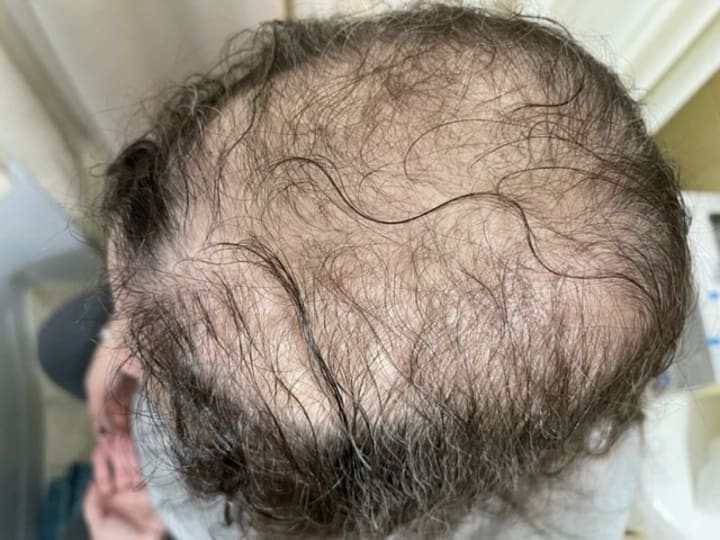
The following events happened so quickly, that I’m surprised I can recount them somewhat clearly. We suddenly heard banging at the front door. It was banging unlike anything I had ever heard. “Police! Open up!” they shouted through the door. It was all so surreal that I didn’t even have the chance to act. In fact, I was frozen in a state of terror. When I initially heard the banging, my first thought was that we were being pranked. Someone had tried to break into our apartment about a month ago, so I knew we had people with bad intentions targeting us. But the door flew open so swiftly and with such force that it wasn’t long until I came to my senses and took in what was actually happening. We were being raided by the Berks County Narcotics Unit.
At the time of the raid, we had three buyers in the apartment and we were all ordered to lie face first on the ground and keep our hands where police could see them. Our hands were pulled behind our backs as the cold, hard steel handcuffs wrapped our wrists. We were harmless hippies. We would never be violent, and we knew escape was not an option. They lined the four men up on their knees and placed me nearby in a chair. Mike and I quietly sang Pink Floyd’s “Two Suns in the Sunset” and cried, while dozens of men ripped our apartment to shreds looking for narcotics, paraphernalia, and anything incriminating they could find.
After what seemed like an eternity, Mike and I did the perp walk out to the police car in front of the entire neighborhood. We were driven to Central Processing at Berks County Courthouse and were handcuffed together on a bench while they tested all the drugs they found. They ended up taking a few ounces of marijuana, an ounce of mushrooms, benzodiazepines, a variety of prescription opiates, pot brownies & butter, 57 hits of LSD, two fentanyl lollipops, a small amount of cocaine, and a rainbow of different glass pieces used for smoking cannabis.
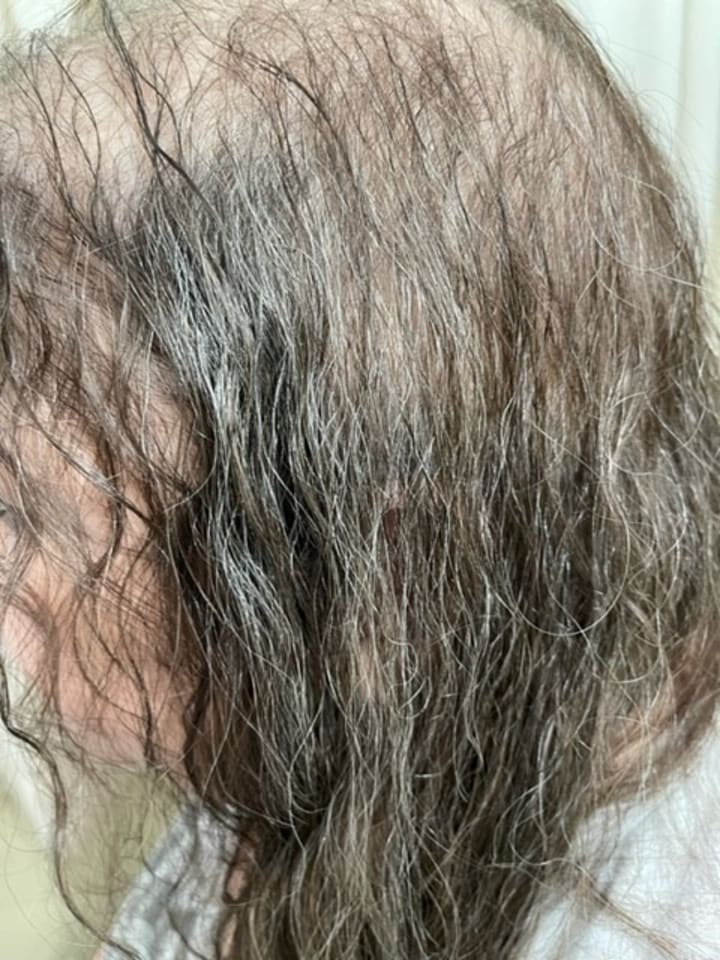
Reality set in when we were finally separated to go see the arraignment judge. At midnight, I stood tired, cold, and hungry in front of an angry old man on closed circuit TV as he set my bail at $1 million. Mike received the same. In my state of desperation, I actually called my mother, woke her up, and proceeded to demand that she come up with $50,000 cash to come get me as the sheriffs in the room laughed.
As I sat in the women’s holding cell waiting for transport to Berks County Prison, I couldn’t stop pulling my hair out. To my relief, the woman who had strip searched me when I arrived didn’t notice that I was wearing a wig. What was going to happen in prison? My anxiety was through the roof as I pondered what prison life would be like and how I could prevent from standing out with my hair situation. At this point, most of the top of my head was bald with some baby hairs growing back and there were large patches in my wig without hair from me pulling it out. Most of the time I was wearing a bandana over my wig. As one can imagine, this was a big deal to me. I didn’t know how they were going to treat my disorder or if they would allow me any dignity and grant me permission to wear my wig.
When I walked into the Berks County prison, I was immediately whisked away to be strip searched. This time I wasn’t so lucky, as the correctional officer (CO) noticed I had a wig when she asked me to shake my hair out. “Can I keep this?” I asked, shaking as I pointed to the wig. “No. There are no wigs or hair extensions allowed,” she coldly replied.
From there, I was forced to shower and hand in my street clothes and wig in exchange for a prison jumpsuit. They gave me a large plastic box which carried a towel, a small bar of soap, a tiny deodorant that I soon discovered did not work, an extra pair of underwear, and an extra pair of pants. They walked me from the holding cell, down the long, angular halls to F Block, the only female block in the prison.
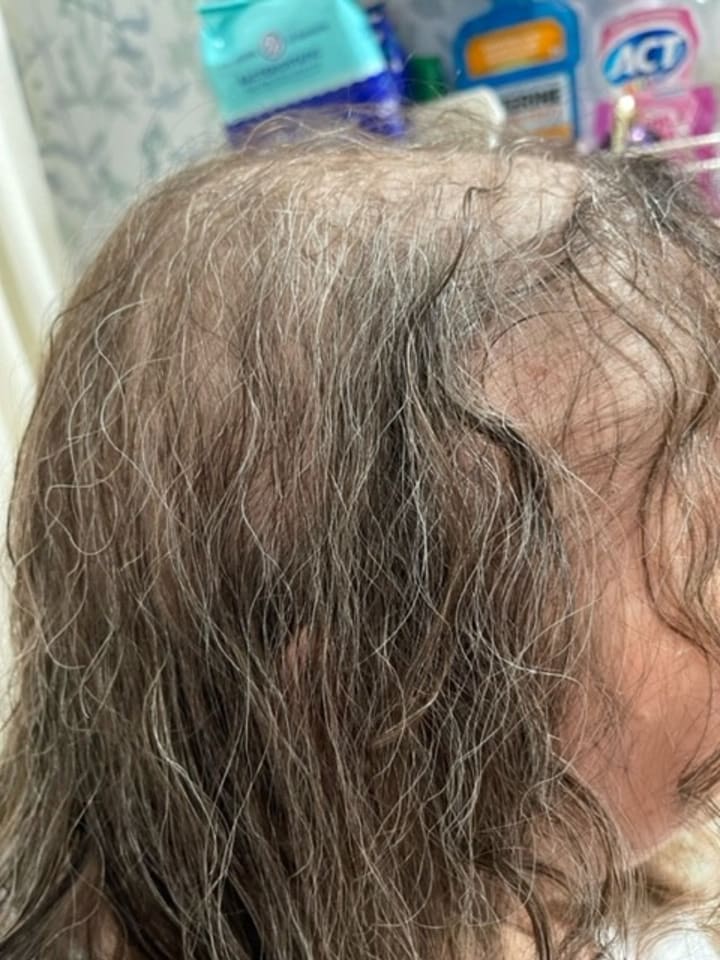
It’s hard to describe the humiliation I felt when they buzzed open the locked door leading to the day room and the CO’s desk. Behind their desk were the quarantine cells, which I would call home for the next 5 to 7 days. I walked in during a period when the inmates were allowed out of their cells to socialize, use the phone, make food or coffee with the microwave, and watch TV. Whenever fresh meat entered the block, everyone stopped to get a look at who was coming in.
Everyone gawked at me in my bright yellow shirt and blue prison-issued pants. My hair, still wet from the shower hung down past my shoulders. At this point, most of the top of my head was bald. The remaining hair was long and thin, some of it kinky and frizzy, some of it overrun with white hairs. I felt like my face was on fire as I tried to ignore the stares. “You look rough,” one of the CO’s said to me, breaking the awkward silence. I couldn’t even respond. Just put me in a cell away from other people judging me, I thought to myself.
I was able to pull my hair back into a ponytail and have it look somewhat normal. You could still tell that it was thin and there were bald spots, but it saved me from the complete and utter mortification that took over my mind, body, and soul when I was forced to wear my hair in its unfortunate state. Unfortunately, they didn’t allow hair ties in quarantine. I really didn’t care about that rule. I fashioned a hair tie out of the cloth from my blanket and sheet. I was not going to let them strip me of my merit any more than they already had.
During the week I spent in quarantine, I was able to speak with a mental health counselor. I broke down and sobbed to her about the humiliating situation I was in and asked if anything could be done. Eventually they decided that if I would agree to see a counselor once a week, I could have my wig back. This was definitely a victory for me, but it didn’t stop the mean and hateful chatter amongst the other inmates.
I heard rumors that people were saying that I lost my hair in a fire. When someone would be bold enough to approach me and ask me why I had a wig on, I didn’t know what to say. This has been a problem for me throughout the entirety of this disorder. Most people don’t know what trichotillomania means. Most people don’t know that hair pulling is a mental health disorder, especially not prison inmates. Most people are just ignorant to this problem. It’s not their fault.
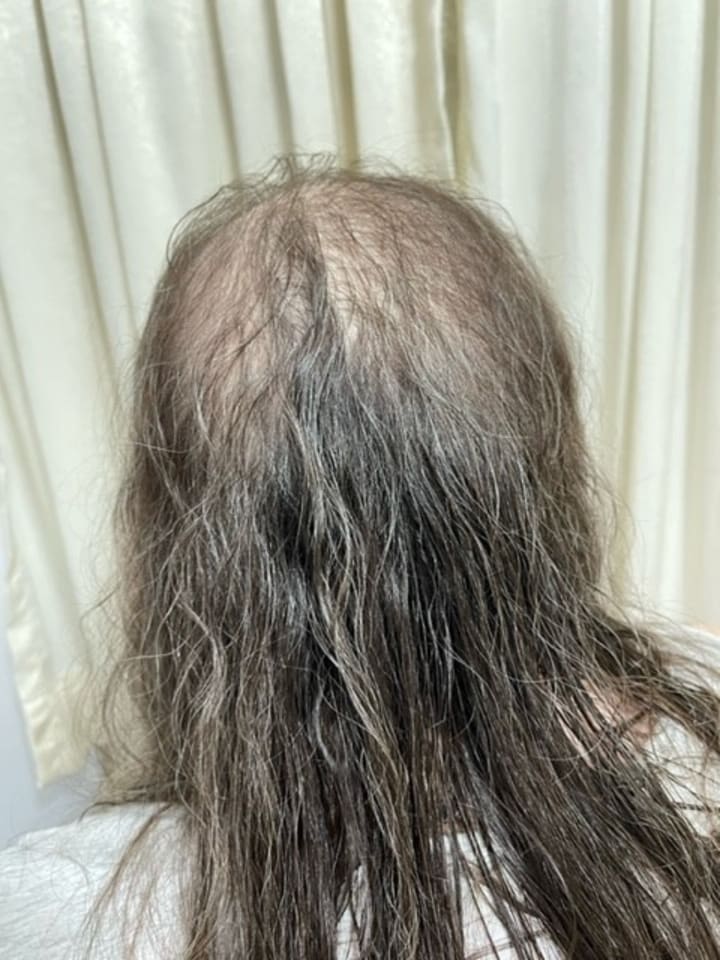
Trichotillomania is just an obscure disorder and those who have it are usually not advertising it to the world like I am right now. Even just yesterday, I was in a therapy group at my methadone clinic and I was sharing about my disorder and neither the therapist nor anyone in the group knew what it was or had ever even heard of hair pulling as a debilitating disorder.
Usually, when forced to disclose my condition, I was very vague and said I had a medical disorder that made me lose my hair. I just don’t feel like I owe an explanation to everyone who’s wondering why I’m wearing a wig. But that burden is there, nonetheless.
I also hated shower time in prison. My wig was falling apart from all the hair I’d pulled from it while smoking crack. It was also beginning to form dread locks because I never took it off in prison-not even to sleep. Depending on the shower I chose there could be 2 to 6 women showering with me. I didn’t wash my hair until I had cleaned everything else. I would quickly remove the wig and hide it between my legs. Then I’d immediately shampoo my hair up on top of my head so the bald spots weren’t noticeable. Then, I’d quickly rinse and put the filthy wig back on. I’m sure that my routine didn’t go unnoticed, but thankfully no one ever said anything to me in the shower.
Because I spent my twenties going in and out of prison, I was forced to deal with the awkwardness and humiliation of my wig being taken quite a bit. Once the CO’s got to know me, their hard exterior was replaced with a bit of compassion for me and they allowed me to keep the wig without all the strings attached. Being in prison with trichotillomania was definitely the most degrading experience I had with this disorder.
Because prisons try to break you down and strip you of your humanity, they failed immensely at dealing with mental health issues, which affected a large amount of the prison population. A report from the U.S. Bureau of Justice states that in 2005, more than half of all federal, state, and county inmates had mental health issues. Sadly, most prisons and jails are not equipped to deal with these problems or they use Draconian measures to treat them.
When I was 27, I left prison for the last time and immediately went out and relapsed. Mike came out about a month later and joined me in my drug-fueled antics. Again, we crashed hard. We were both at rock bottom and after trying various treatment methods that didn’t work, we went to the methadone clinic in utter desperation. It took me four months at the clinic until I could kick heroin for good.
Shortly after I stopped shooting up, I became pregnant with my youngest son. Life was beginning to transform. Mike got a job at Goodwill and I decided to go back to school to earn my Bachelor’s degree. I gave birth to my son three weeks before my first semester commenced. After getting clean, my hair pulling decreased, but it was still an issue.
Now that I was clean, I cared deeply about how I looked and taking care of my hygiene. I spent a lot of time picking out fashionable outfits, putting on makeup, and treating myself to these luxuries that I couldn’t afford while addicted to heroin because all of our money had to go to drugs, paraphernalia, cigarettes, and gas to drive into the city.
I decided it was time to find a proper wig. I had no idea what to look for or even where to buy a decent wig. First, my friend took me in the city where they had a few stores with human and synthetic hair. I went through a lot of trial and error before I figured out the pros and cons of each type of wig. The human hair wigs felt and looked more realistic. They were also ready to be dyed, curled, straightened, cut, or styled. Unfortunately, I found out it’s not easy to work on a wig. I didn’t have a stand, which made it very difficult to curl, and often times the curls would fall out after an hour or two.

The worst part about the human hair wigs is that they were constantly losing hair. I remember one day, I simply pulled my hair out of my face and behind my ear and I ended up with a handful of hair. It came out with just the slightest touch. These wigs didn’t last more than four to six months before a bald spot would develop (this was NOT from me pulling) and I started to feel like they weren’t worth their $350 price tags. The other problem with human hair is that prices range from in the $1000’s to about $100. With such a large scale, how can you discern if a wig is of good quality? Does that mean that a $500 wig is only mediocre? I just didn’t have the money to keep buying myself human hair wigs that didn’t last.
Synthetic wigs are much less expensive but can also look cheap. The hair comes pre-styled, which is nice because you don’t have to spend any time fixing your hair in the morning. Sadly, these wigs have an even shorter duration than human hair wigs. A decent one will last about a month to six weeks. Amazingly, I’ve even seen synthetic wigs with crazy prices. I once bought a $300 synthetic wig, thinking it had to be fantastic if it was priced so high, only to discover that it was the same quality as my $40 synthetic wigs. The worst part about these wigs is that they deteriorate quickly. The hair underneath that rubs against one’s clothing becomes tangled, frizzy, and kinky and there’s nothing anyone can do to salvage it.
Wigs are hot, itchy, and annoying. I’m constantly worried that it’s going to blow off on a windy day. I cannot wear my hair in unique styles. My foundation makeup stains my blonde hair, which is the color I’ve been wearing for awhile. I absolutely hate wearing wigs. But, I think I’m coming to a point where I accept them. Short of a hair transplant, which I can’t afford, I’m stuck in this cycle.
As for the last year, I’ve been buying $40 synthetic wigs, wearing them for a month, and then discarding them in favor for a new wig. This way, I have something fresh every month. I’m currently hooked on being a blonde, but I have a variety of different colors and lengths that I can easily switch to when I get bored. I’ve also been buying shorter wigs so that the hair doesn’t become kinky so quickly.
After I got clean, had my youngest son, and went back to college, my hair pulling had drastically decreased. Unfortunately, it always seems to make itself known when trauma surfaces.
In December of 2013, I lost my beloved fiancé. He was 27 years old. I don’t want to go into too many details about his death, as I plan to write about this tragedy separately. Everything that I thought I knew was completely shattered within a few hours. I was so shocked and overwhelmed by grief that I was moving on autopilot. My wonderful mother stepped in to help with the kids, as I couldn’t handle much.
Each day I would open my eyes, only to be crushed by reality, collapsing down upon me. My brain couldn’t process that he was gone. I’d literally walk in circles because I didn’t know what to do with myself. I would shuffle from the bed I was sharing with my sister because I couldn’t sleep in our bed and I couldn’t be alone, to the front porch, where I sat, chain-smoking cigarettes in the freezing cold.
All of the progress I had made with my hair pulling was for naught. I was so filled with anxiety that I could barely move. My stomach was so twisted in knots that I was defecating sometimes more than ten times a day. Even the pulling provided little relief.
Within a week of my fiancé’s death, I was at a psychiatrist’s office, begging for help. At first, I didn’t talk about the hair pulling. Sadly, I didn’t feel like anyone was listening to or at least understanding what I needed.
Finally, I got serious with my psychiatrist. I told her that I was in a really scary place. I also took my wig off and showed her my hair. She was truly taken aback as I hadn’t really talked about my trichotillomania at all. She made some adjustments to my medication. Slowly, but surely, I started to come alive once again.
It took me seven years to get stabilized on medication that actually works for me. During those seven years, I tried so many different drugs and felt no reprieve for my aching soul. I don’t know what I expected. I don’t think any amount of any drug, whether it be an antidepressant or my drug of choice, heroin, could have eased my pain during that time.
Sadly, I had to take a break from school, as I could no longer function. I spent a long time stuck within the confines of my own mind-not a pretty place to be. I couldn’t go to school, I couldn’t get a job, and I gained a lot of weight after I initially lost 40 lbs because I had lost my appetite.
It’s been a little over a year since my psychiatrist made the changes to my medication that actually worked. I cannot emphasize enough how gradual my progress has been. I started a diet to lose some weight and get my health back in check. I’ve neglected my health my entire life and I had a wake up call when I was told that I had high blood pressure at 39 years old.
I’m trying to get back into school. I decided that I didn’t want to return to my old university, as I don’t want to relive the trauma I suffered while attending class there. I’ll never forget my first semester back after my fiancé died. I remember roaming around campus, seemingly without purpose, trying to focus on my classes, but having my thoughts hijacked by the hell that I had just endured.
Instead of returning to that school with those memories, I’ve found a way that I can attend college online and finish my Bachelors degree. Education means so much to me, as it helped me form my new identity when I was getting clean from drugs. I want to do this, not only for me, but to make my children and my family proud.
I’ve also found solace at Medium. My mental health and weight issues have kept me from holding a job in the traditional sense. I finally had the idea to try freelance writing because it’s my only tangible skill and Medium was my first attempt at making this dream come alive. I don’t know where this journey will take me, but I’m eternally grateful for a kind and compassionate community with whom I may share my work and possibly make a living out of something I love to do.
Most importantly, I’m at the point where I barely pull my hair out. I stopped pulling the hair out of my wigs. I would say, on average, I might pull 3–6 hairs of which I’m aware every week. It only happens during times when my wig is off. Sometimes when I’m getting ready for a shower, I’ll pull a hair or two out. At night I wear my hair up in a bandana to prevent my fingers from traveling up to my head. But every now and then, I’ll pull a hair out at night.
I have to keep my hands busy. This is so important when it comes to behavior modifications you can make with trichotillomania. I have a number of coping skills that I use to keep my hands moving. I write, I smoke (this is a bad coping skill that I’m working on quitting), I paint my nails, and I play video games in my spare time. Sometimes I’ll keep a hair tie around my wrist to snap when I catch myself subconsciously wanting to pull. I’ve also considered learning how to knit. That would be an excellent, productive way to keep my hands from foiling my attempts to remain pull-free.
I think my desire to pull depends a lot on my current level of anxiety. But I can finally say that with my medication adjustments and my behavioral modifications, I have this disorder under my control. While I never thought this day would come, I have to admit that it’s bittersweet.
Most of my hair will NOT grow back. I have done so much damage over the years by repeatedly pulling my hair out. The follicles have been damaged to the point of no return. The follicles that produce the kinky and white hairs are also damaged. I must admit that the main goal I had in mind while trying to stop pulling was to one day have my beautiful, thick hair back. I have to accept that my dream will never become reality. I’m stuck with these wigs and just trying to make the best out of a bad situation.
To anyone who may be reading this that suffers from trichotillomania: YOU ARE NOT ALONE! YOU ARE NOT A FREAK! You have a difficult to combat, but treatable disorder. Please don’t make the mistakes that I made. If you notice that you’re experiencing any of the symptoms that I’ve talked about in this article, realize that these symptoms have a name and there are others suffering too. Don’t be ashamed of who you are or for asking for help. Requesting psychiatric assistance comes from a place of strength. You are so brave and you can treat this disorder and get your hair back as long as you don’t do what I did and pretend that nothing is wrong.
Please help me spread awareness about this disorder. If you know someone who’s suffering from trichotillomania, be as empathetic as possible. Never judge someone for pulling out their hair. We’re not crazy, we just need patient and compassionate treatment. My hope is that educational institutions will start teaching about this disorder in psychology classes, instead of only abnormal psychology electives. At the very least, a therapist should know what trichotillomania means.

Published on Medium on March 8, 2022.
If you enjoyed this piece, please consider buying me a coffee. It's only $5 and it helps me out tremendously and enables me to continue writing. Thank you in advance for your kindness and generosity!
About the Creator
Monica Leigh French
Student. Writer at www.medium.com/@MonicaLeighFrench. I’m mostly inspired by writing about personal experiences, politics, addiction, and mental health issues. Pink Floyd fanatic. Twitter: @french_monica.






Comments
There are no comments for this story
Be the first to respond and start the conversation.